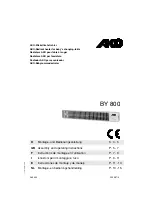
Instruction manual DXB heater
page 7
4.2 Connecting the Fuel supply
The oil connection must comply with national and regional installation regulations.
You can connect the oil heater to a single oil pipe (figure) or an oil pipe with return (figure). Fit
return pipe E to the oil pump connection R (figure 12). Fit supply line D to oil pump connection
S. There are two hose connectors on the outside of the heater, around the supply and return
lines. Use hoses which are resistant to oil and any harmful substances which may be present
locally (such as ammonia fumes). Make sure the return and supply lines are properly
connected. An oil filter must be fitted to the heater’s supply line. The return pipe can be sued to
feed air back to the ventilation pot/flow control.
To guarantee a good supply of oil, all the parts in
figures 6 or 7 must be included. This prevents
malfunction in the oil heater.
The intake pressure of the oil pump must be
between 0 and 2 bar. The suction height of the
heater oil pump is a maximum 3 metres.
Single oil pipe (figure)
If the oil heater is connected to a single oil pipe, a
flow control (such as tigerloop) should be fitted.
Position the flow control higher than the oil tank in relation to the tank running dry. Do not fit the
supply and return lines higher than the flow control to the tank. This prevents the formation of air
bubbles.
Oil pipe with return (figure )
If the oil heater is connected to an oil pipe with
return, an air ventilation pot must be fitted.
Position the ventilation pot higher than the oil
tank in relation to the tank running dry.
Key to letters in figures:
A = Flow control (e.g. Tigerloop)
I=
(Transfer) pump
B = Oil pump
J=
Overflow valve
C = Oil filter
K = Filter/water separator
D = Supply line
L=
Dirt filter foot valve
E = Return line
M = Cut-off (manual)
F = Ventilation pot
N = Main pipe
G = Manometer
O = Vacuum meter
H = Oil
P=
Back pressure valve
The heater can be converted from one fuel to the other. This involves changing the nozzle and
adjusting the pump burner pressure. Look into the specifications for the exact adjustments.
Instructions can be found in this manual.








































